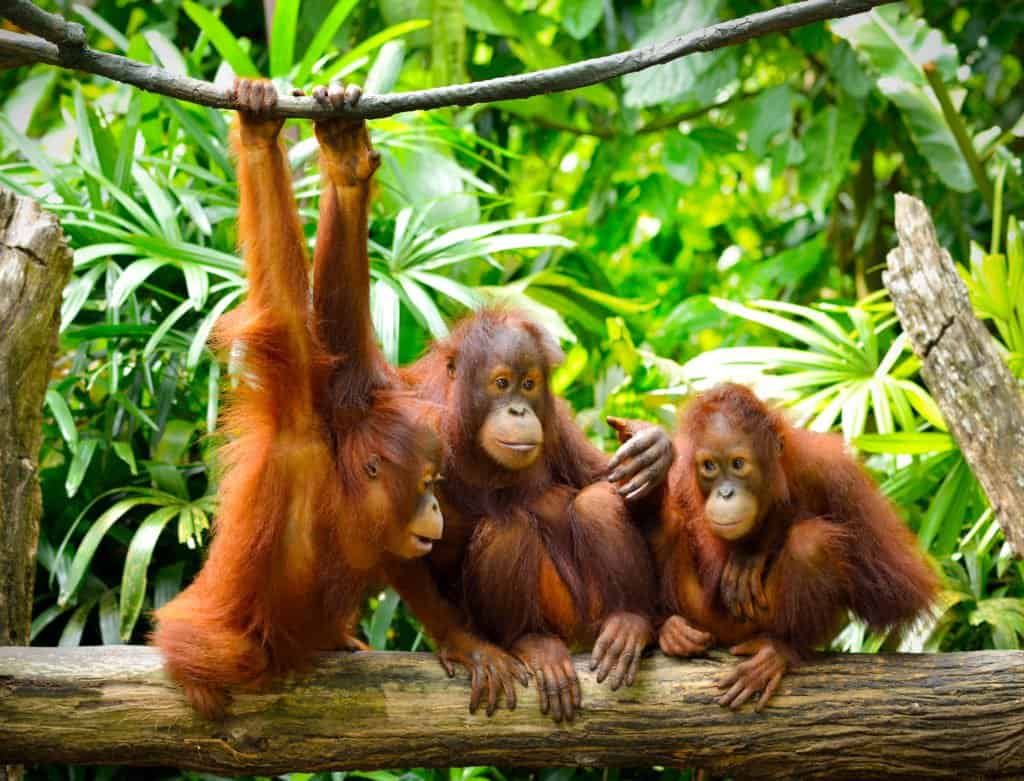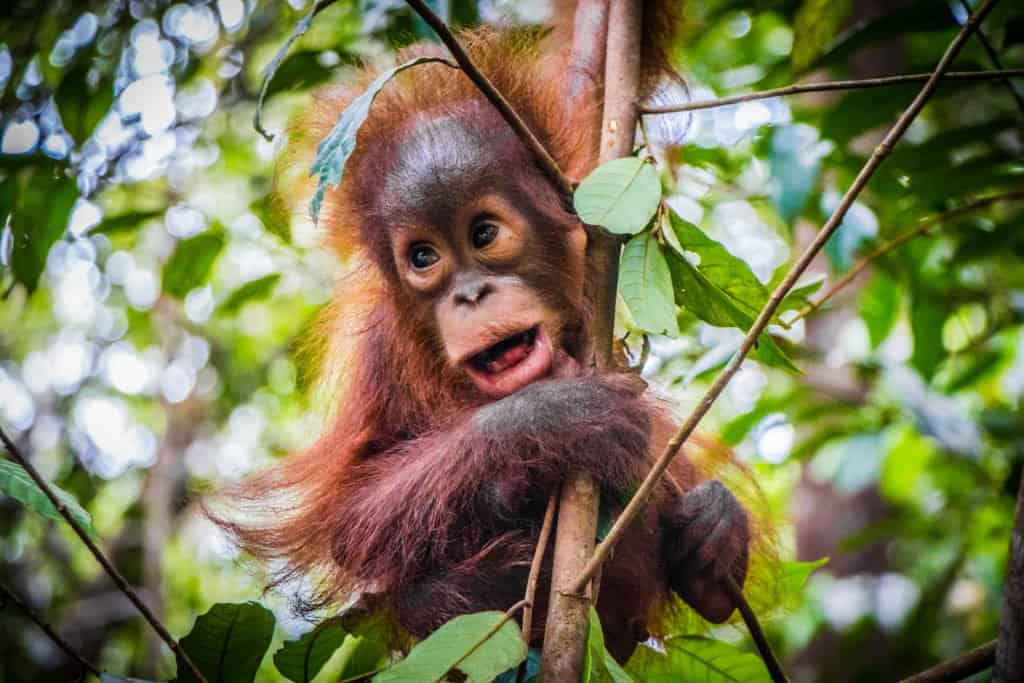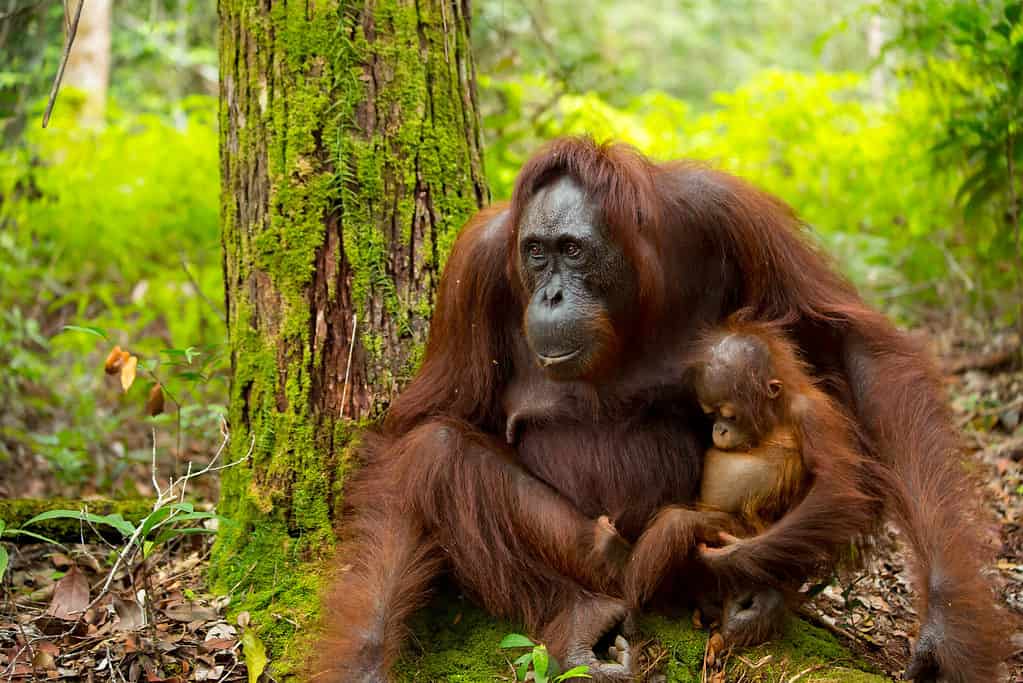Orangutans are highly arboreal apes which are known for their distinctive red fur and long arms. They are native to Indonesia and Malaysia, where they inhabit the rainforests of Borneo and Sumatra islands. However, with such a limited distribution, they face several threats to their survival. With this in mind, you may be wondering whether orangutans are endangered, so keep reading to find out!
Where Do Orangutans Live?
There are currently three species of orangutans — Bornean, Sumatran, and Tapanuli. There were initially only two species, but the Tapanuli species was officially classified in 2017. Orangutans have a limited distribution and are only found on the islands of Borneo and Sumatra in Asia. However, they formerly had a much wider distribution across the southern region of China and throughout the majority of Southeast Asia. Today, orangutans live only in the rainforests on the two islands. Orangutans are highly arboreal animals, spending the vast majority of their lives high up in the trees. They are “semi-solitary” animals, typically preferring to live alone instead of in large family groups.
The most significant bonds that orangutans form are those between a female and her offspring, who remain with her until they are approximately six to seven years old. Orangutans have a particularly long nursing period, and the young will continue to suckle from their mother throughout this period. However, they also learn other important things from their mother during this time, such as how to forage for food. Orangutans eat a wide variety of fruit, as well as some plants, leaves, and insects. On rare occasions, they even sometimes eat small mammals.
How Many Orangutans Are There in the World?

Orangutans are critically endangered and their population is in decline.
©tristan tan/Shutterstock.com
All three species of orangutans — Bornean, Sumatran, and Tapanuli — are considered to be critically endangered. There are around 120,000 orangutans left in the world (although some estimates suggest that this number may be much lower). Of these, around 104,700 are Bornean orangutans. This species has the greatest population, though, as there are only around 13,850 Sumatran orangutans and just 800 Tapanuli orangutans.
There are three subspecies of Bornean orangutans — Central, Northeast, and Northwest. The Northwest Bornean orangutans are the most threatened subspecies, with only around 1,500 of them left.
Here’s a quick breakdown of the figures.
| Species | Population Size |
|---|---|
| Bornean Orangutan | 104,700 |
| Sumatran Orangutan | 13,850 |
| Tapanuli Orangutan | 800 |
| Bornean Subspecies | Population Size |
|---|---|
| Central Bornean | 35,000+ |
| Northeast Bornean | 16,000 |
| Northwest Bornean | 1,500 |
What Threats Do Orangutans Face?

Orangutans face several threats, including habitat loss and poaching.
©Alex East/Shutterstock.com
It is estimated that there were more than 200,000 orangutans around 100 years ago, but unfortunately, they face several different threats now. These constant threats have caused a sharp decline in their population and are pushing these beautiful animals closer to extinction.
Hunting
Unfortunately, hunting is a major threat that orangutans face. Although some are hunted and killed for food, others are killed simply because they are trying to eat. Human settlements are becoming closer and closer to the orangutan’s natural habitat, and sometimes they try to eat fruit from gardens and farms, meaning that they are labeled as “pests” and killed.
Quite often, adult females are among those killed, and their young (who usually stay with them for up to seven years) are left as orphans. Many of these orphans are sold into the illegal pet trade, and in many cases, the mother orangutan is deliberately killed just so that her babies can be taken from her. Unfortunately, the babies themselves may also die from falling out of the trees when their mother is killed. As sweet as they look, orangutans do not make good pets as they are wild animals and require the freedom to live and roam in their natural habitat.
Habitat Loss
Another major threat that orangutans face is habitat loss due to deforestation for logging, palm oil plantations, and encroaching human settlements. Orangutans do not have a large distribution as it is. Bornean orangutans live only in the states of Sabah and Sarawak and in the Kalimantan area, all on Borneo Island, while Sumatran orangutans live only in the northern region of Sumatra Island. The Tapanuli orangutan has an even smaller distribution, living only in the South Tapanuli region in an area of only 390 square miles.
Deforestation and the planting of palm oil plantations are massive threats to the orangutans and their already limited habitat area. Thousands of acres of forests are destroyed, resulting in the loss of both their home and their source of food. The destruction of their natural habitat is forcing them into a smaller and smaller area, or in many cases, leaving them completely homeless. As a result, it’s also bringing them into much closer contact with humans. This often ends in the conflict mentioned above as they seek food and shelter near human settlements.
Slow Reproductive Rate

Orangutans only give birth once every eight years.
©Katesalin Pagkaihang/Shutterstock.com
As we’ve already mentioned, orangutans have one of the longest nursing periods in the world, with their babies remaining with their mothers for around seven years. However, orangutans do not have any other babies during this time, meaning that they typically only give birth once every eight years. Furthermore, orangutans don’t reach sexual maturity until they are between the ages of 11 and 15. The combination of these two factors means that orangutans have a slow reproductive rate. This, along with the high numbers of orangutans that are killed, means that their population is in serious decline.
Conservation Efforts
Thankfully, conservation efforts are underway to try to save these incredible animals, although it is an ongoing battle. Conservation efforts include protecting their remaining habitat, rescuing and rehabilitating orphaned orangutans, attempting to stop illegal poaching, educating the local communities, and promoting sustainable solutions.
Organizations such as the World Wildlife Fund (WWF) are working closely with government agencies to prevent the illegal capture of the orangutans. They also work to rescue those who have been taken so that they can be rehabilitated at an orangutan orphanage and eventually returned to the wild.
However, one of the biggest steps that is being undertaken is to protect large portions of the rainforests where the orangutans live. This is to prevent any further habitat loss and to provide a safe area to release the rehabilitated juveniles. Unfortunately, at the moment there are still many orangutans that live outside of these protected areas. That’s where the education of the local communities comes in to try to prevent the orangutans from being labeled as pests and shot. However, it’s also to try to gain local support against deforestation.
The photo featured at the top of this post is © molishka1988/iStock via Getty Images
Thank you for reading! Have some feedback for us? Contact the AZ Animals editorial team.






